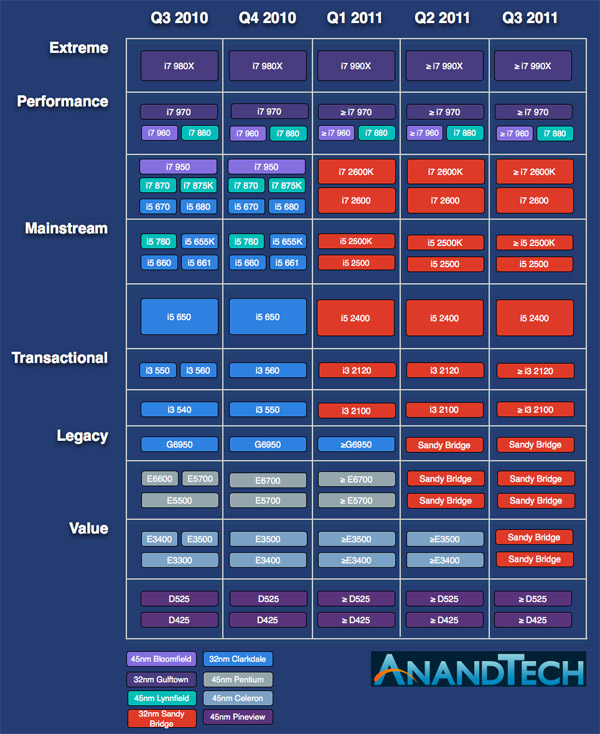The Sandy Bridge Preview
by Anand Lal Shimpi on August 27, 2010 2:38 PM ESTThe Roadmap & Pricing
I’ve defined the launch parts earlier in this article, but now I’m going to put them in perspective. When Intel provides its partners with roadmaps it also provides them with an idea of where future CPUs slot into various segments/price points. For example, Intel’s LGA-1366 roadmap tell us that in the “Extreme” market segment Intel only has a single product offering: the Core i7 980X. And in Q1 2011 the 980X gets replaced by the 990X.
Usually based on this information you can get a general idea of how much future products will cost - or at least what they will be comparable to. In this example the 990X will most likely be priced at whatever the 980X is priced at. Products may change, but the price people are willing to pay in a certain market segment usually doesn’t.
What we have below is the Intel roadmap, with Sandy Bridge included, for Q3 2010 through Q3 2011. The further out you go in a roadmap the lower your accuracy becomes, so I wouldn’t worry too much about us not seeing LGA-2011 on there yet.
It’s based on this roadmap that I mentioned some pricing earlier. If all stays the same, the Core i7 2600K will take the place of the Core i7 950, currently priced at $562. The 2600 will fit somewhere around the 680 and 875K ($342) and the 2500K will replace the i5 760/655K ($205 - $216).
The cheapest Sandy Bridge at launch will be the Core i3 2100, which will replace the i3 560 at around $138.
Now pricing is always a huge variable, but I have to say, based on the performance you’re about to see - these parts would be priced right.











200 Comments
View All Comments
teohhanhui - Saturday, August 28, 2010 - link
Just something like nVidia Optimus? Perhaps Intel could come up with a more elegant solution to the same problem...hnzw rui - Friday, August 27, 2010 - link
Hmm, based on the roadmap I actually think the i7-2600K will be priced close to the i7-875K. The i7-950 is supposed to drop to $294 next week putting it in the high end Mainstream price range (it'll still be Q3'10 then). Also, all the $500+ processors are in the Performance category (i7-970, $885; i7-960, $562; i7-880, $562).If the i7-2600K goes for $340 or thereabouts, I can already see supply shortages due to high demand (and the eventual price gouging that would follow).
liyunjiu - Friday, August 27, 2010 - link
How are the comparisons between NVIDIA low end discrete/mobile graphics?tatertot - Friday, August 27, 2010 - link
Hey Anand,How could you tell that this sample had only 6 execution units active in the GPU vs. the full 12?
Was it just what this particular SKU is supposed to have, or some CPU-Z type info, or... ?
thx
Anand Lal Shimpi - Saturday, August 28, 2010 - link
Right now all desktop parts have 6 EUs, all mobile parts have 12 EUs. There are no exceptions on the mobile side, there may be exceptions on the desktop side but from the information I have (and the performance I saw) this wasn't one of those exceptions.Take care,
Anand
steddy - Saturday, August 28, 2010 - link
"all mobile parts have 12 EUs"Sweet! Guess the good 'ol GeForce 310m is on the way out.
mianmian - Saturday, August 28, 2010 - link
The mobile CPU/GPU usually has much lower frequency.I guess the 12EU mobile GPU will perform on pair with the desktop 6EU one.
IntelUser2000 - Saturday, August 28, 2010 - link
That seriously doesn't make sense. Couple of possible scenarios then.-Performance isn't EU bound and 2x EUs only bring 10-20%
-The mobile parts are FAR faster than desktop parts(unlikely)
-The mobile parts do have 12 EUs, but are clocked low enough to perform like the 6 EU desktop(but why?)
-There will be specialized versions like the i5 661
DanNeely - Sunday, August 29, 2010 - link
Actually I think it does. Regardless of if they 6 or 12EU's it's still not going be a replacement for any but the bottom tier of GPUs. However adding a budget GPU to a desktop system has a fairly minimal opportunity cost since you're just sticking a card into a slot.Adding a replacement GPU in a laptop has a much higher opportunity cost. You're paying in board-space and internal volume even if power gating, etc minimizes the extra power draw doubling the size of the on die GPU will cost less than adding an external GPU that's twice as fast. You also can't upgrade a laptop GPU later on if you decide you need more power.
Anand Lal Shimpi - Tuesday, August 31, 2010 - link
I spoke too soon, it looks like this may have been a 12 EU part. I've updated the article and will post an update as soon as I'm able to confirm it :)Take care,
Anand